Ever wondered how to create a kitchen that feels like a tranquil retreat amid the hustle and bustle of everyday life? Japandi design, a perfect blend of Japanese minimalism and Scandinavian coziness, has taken the home decor world by storm—and for good reason. Its emphasis on clean lines, natural materials, and calming palettes makes it an ideal choice for anyone seeking a space that promotes relaxation, balance, and understated elegance.
In this article, you’ll discover a wealth of inspiring ideas and practical tips to elevate your kitchen into a serene sanctuary. From choosing the right color schemes to clever storage solutions and subtle lighting, these Japandi-inspired concepts are designed to help you craft a harmonious environment. Whether you’re starting from scratch or simply looking to refresh your current space, you’ll find creative ways to incorporate simplicity and warmth—making your kitchen both beautiful and peaceful.
1. Opt for a Neutral Color Palette to Create Serene Ambiance
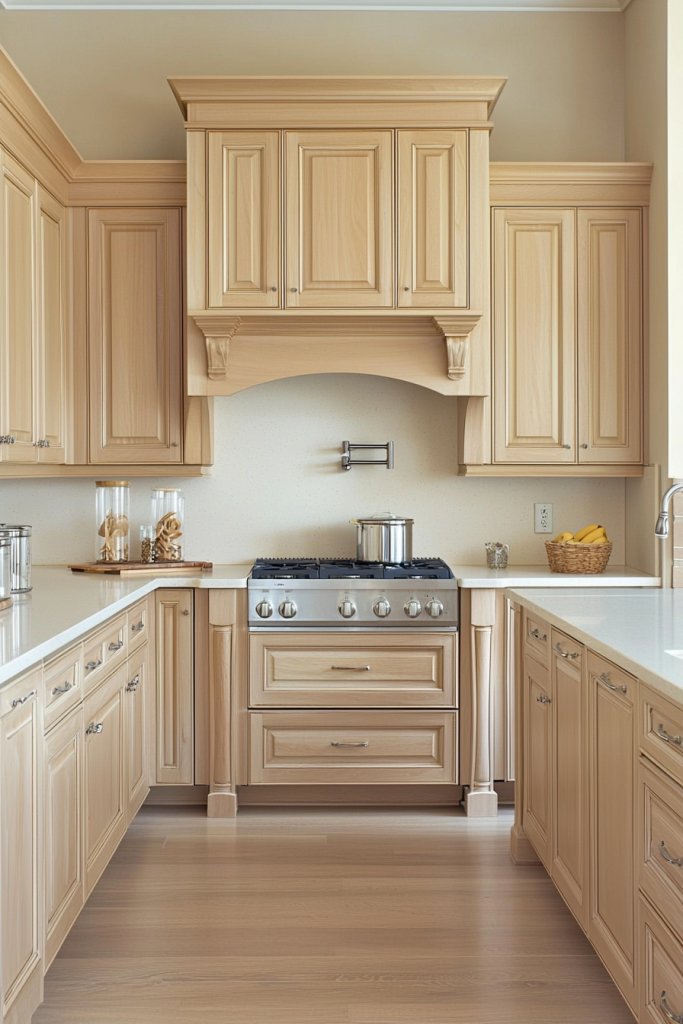
Creating a calm and balanced kitchen starts with choosing a neutral color palette that soothes the senses and provides a versatile backdrop for other design elements. This approach minimizes visual clutter and fosters a peaceful environment, perfect for relaxation and mindful cooking.
A palette of soft beiges, warm taupes, gentle grays, and creamy whites anchors the space in understated elegance, making it easier to incorporate natural textures and materials. Imagine a kitchen where the walls are painted in a soft, warm beige, complemented by light oak cabinets and countertops in a creamy marble finish.
Subtle accents like a matte white backsplash and brushed metal fixtures enhance the understated look without overpowering the space. The overall effect is a harmonious, light-filled environment that feels open, airy, and inviting—perfect for unwinding or gathering with loved ones.
The neutral tones also serve as a calming canvas that can adapt effortlessly to seasonal changes or personal style shifts. To recreate this look, start by selecting wall colors in shades like warm greige or soft taupe.
Use natural materials such as birch or oak wood for cabinetry and shelving, and opt for matte or satin finishes for appliances and fixtures to maintain a serene vibe. Keep decorative accents minimal—think a few ceramic bowls or woven baskets—so the space remains uncluttered and tranquil. This simple yet sophisticated palette ensures your kitchen remains a peaceful haven.
2. Incorporate Minimalist Open Shelving for a Clutter-Free Look
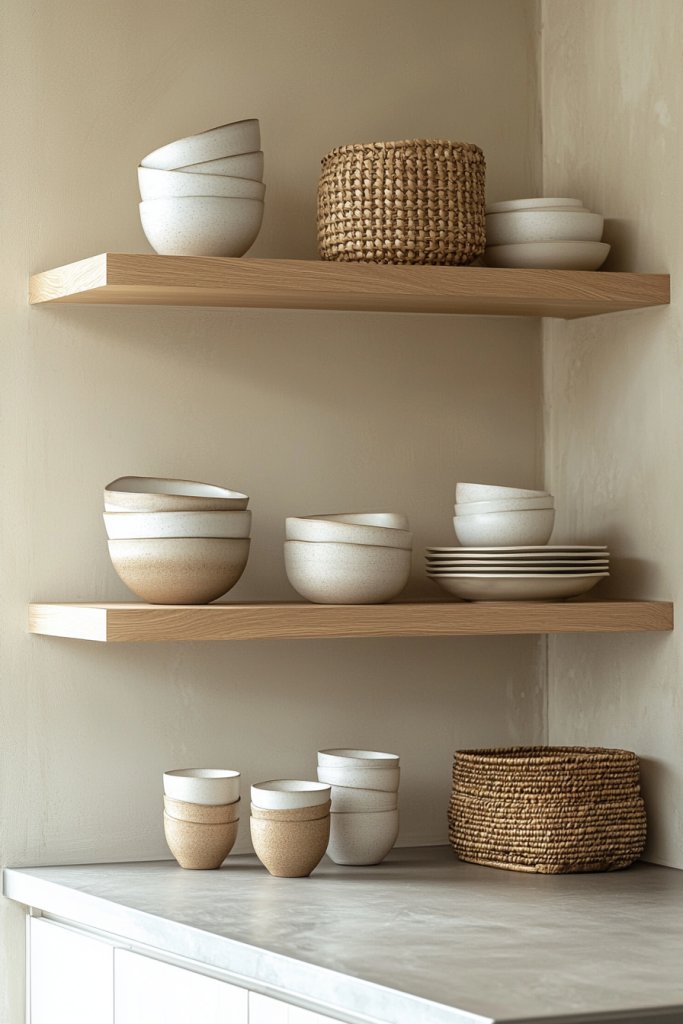
Open shelving in a minimalistic style is a hallmark of Japandi kitchens, offering both functionality and aesthetic appeal. It allows you to display carefully curated items while keeping the space open, airy, and free of bulky cabinets.
This approach encourages intentionality, where each piece is chosen for its beauty and purpose, contributing to a clean, organized look. Picture sleek, floating wooden shelves in a light oak or ash finish, mounted against a neutral wall.
These shelves hold simple, elegant dishes, textured ceramic cups, or woven storage baskets, arranged thoughtfully to create visual balance. The open space beneath the shelves invites natural light to flow freely, giving the kitchen a fresh, spacious feel.
The overall effect is a harmonious blend of form and function, with a calming visual rhythm that promotes clarity and order. To implement this idea, select light-toned wood or matte black metal brackets to support your shelves.
Keep the collection of items on display minimal—use uniform dinnerware, neutral-colored ceramics, or minimalist glass jars—so the shelves serve as a curated gallery rather than cluttered storage. Mount the shelves at a height that’s accessible yet unobtrusive, and keep the surrounding walls painted in complementary neutral shades to maintain a serene atmosphere. This simple upgrade enhances both the beauty and practicality of your kitchen.
3. Choose Streamlined Cabinetry with Simple Hardware
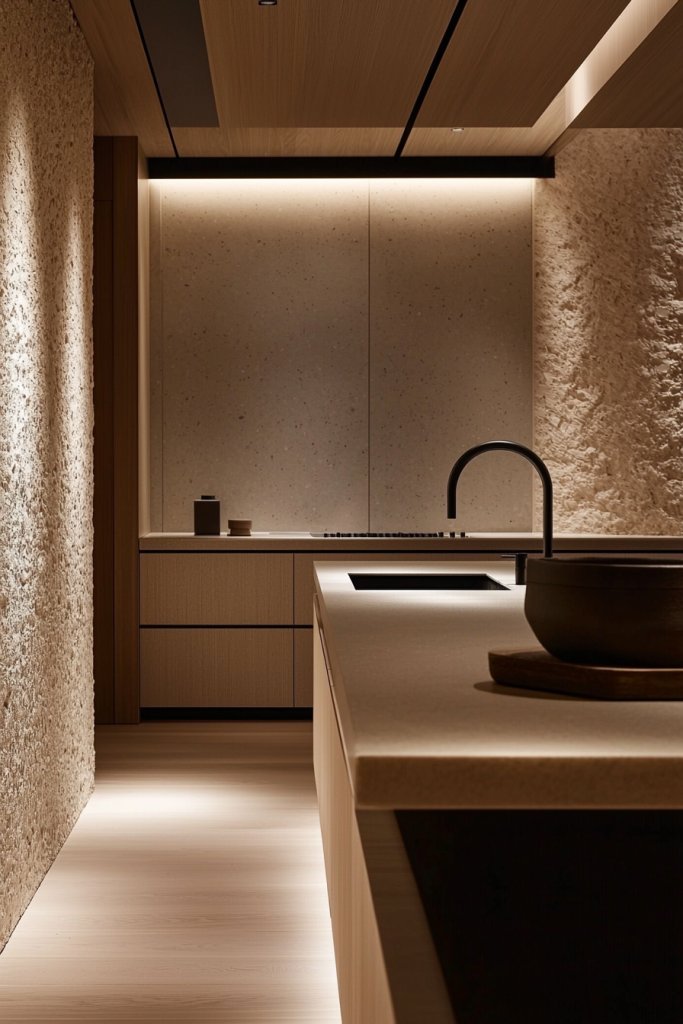
Streamlined cabinetry with sleek, unadorned hardware is essential for achieving a Japandi kitchen’s minimalist aesthetic. It emphasizes clean lines and functional design, reducing visual noise while creating a sophisticated, cohesive look.
The hardware should be subtle and unobtrusive—think slim, matte black or brushed nickel handles, or even handleless designs with push-to-open mechanisms. Visualize cabinetry in matte or satin finishes, with flat-front doors that extend from floor to ceiling, minimizing seams and interruptions in the visual flow.
The hardware, if used, is discreet—small, matte black pulls or integrated grooves—so the focus remains on the smooth, uninterrupted surfaces. This simplicity allows natural materials and textures to shine, reinforcing the tranquil, balanced atmosphere of the space.
To achieve this, choose cabinetry made from natural wood or laminate in neutral tones. Opt for handleless doors with a push-to-open system or minimalist hardware such as small, matte black pulls.
Keep countertops clear, and avoid overly ornate details, ensuring the cabinets contribute to a sleek, uncluttered look. The result is a modern, serene kitchen that feels both functional and aesthetically refined, perfect for those seeking calm and order.
4. Use Natural Wood Finishes to Add Warmth and Texture
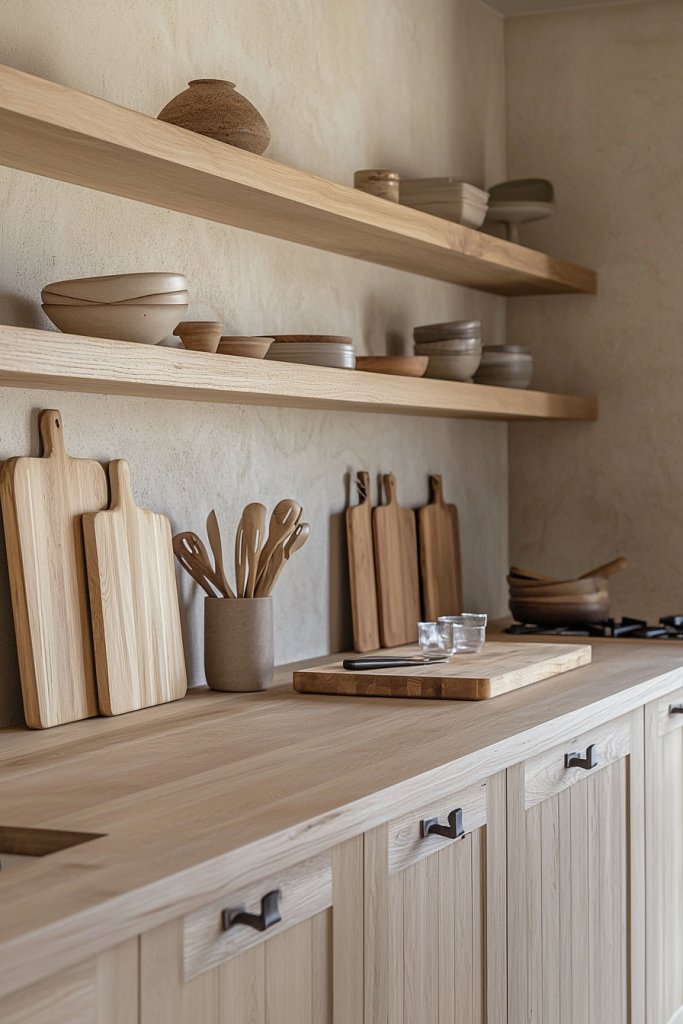
In a Japandi kitchen, natural wood finishes serve as the backbone of the design, bringing warmth, texture, and an organic feel that balances the coolness of neutral colors. Wood introduces subtle variations in tone and grain, creating visual interest and tactile richness without overwhelming the space.
It’s a fundamental element that anchors the aesthetic in nature-inspired simplicity. Picture a kitchen with light oak or ash cabinetry, complemented by a wooden countertop in a slightly darker shade to add depth.
Open shelves, cutting boards, and utensil holders in matching or contrasting wood finishes enhance the organic theme. The scent of natural wood, combined with the tactile feel of smooth or textured surfaces, deepens the sensory experience.
The overall atmosphere is cozy yet uncluttered, inviting a sense of calm and groundedness. To incorporate this element, opt for natural wood veneer or solid wood for cabinets, shelves, or accents.
Use sustainably sourced materials when possible to enhance eco-friendliness. Pair wood surfaces with neutral-colored walls and simple accessories, like ceramic jars or linen towels, to keep the look cohesive and serene. This strategy creates a warm, tactile environment that is both inviting and timeless.
5. Select Matte Finishes for Appliances and Fixtures to Enhance Calmness
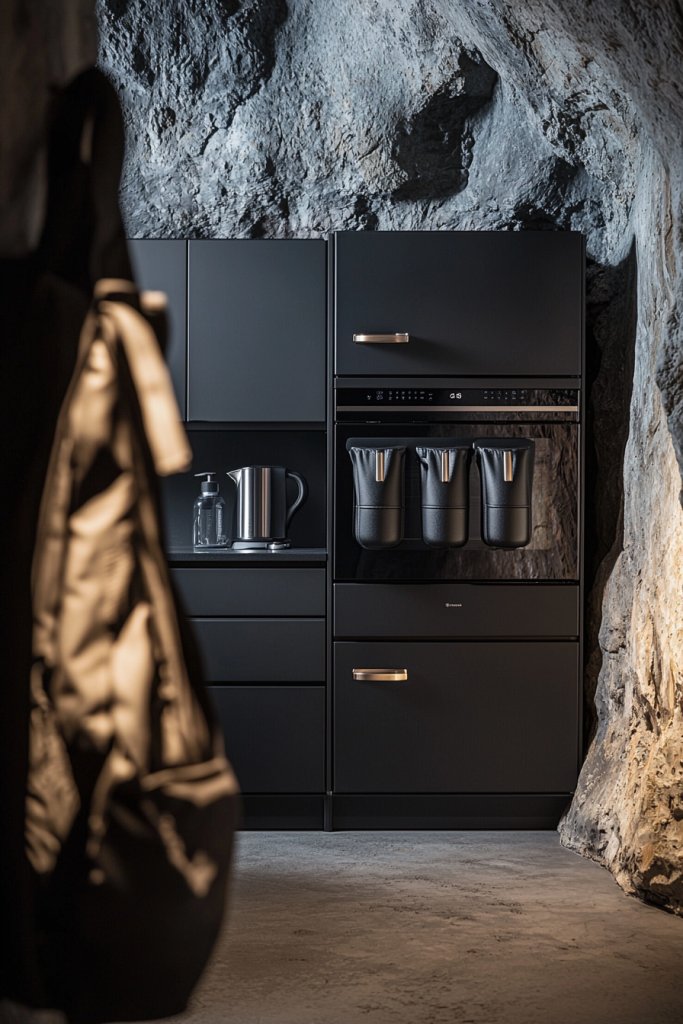
Matte finishes on appliances, fixtures, and hardware are a subtle yet powerful way to reinforce the tranquil, understated aesthetic of a Japandi kitchen. Unlike glossy surfaces, matte finishes diffuse light and minimize reflections, contributing to a soft, calming ambiance.
This choice helps create a space that feels cohesive, modern, and peaceful. Visualize matte black or brushed nickel appliances—like a built-in oven, refrigerator, or faucet—that seamlessly blend into the cabinetry.
Fixtures such as cabinet handles, sink fittings, and light switches in matching matte finishes further unify the design. The absence of shine prevents visual distractions, allowing natural textures and neutral tones to take center stage, cultivating a sense of calm and order.
To achieve this look, select appliances with matte or satin finishes, or consider adding matte wraps or panels if replacing appliances isn’t feasible. Use matte black or brushed metal fixtures for sinks, faucets, and cabinet hardware.
Keep the overall color palette in soft, neutral hues to enhance the subdued, serene quality. This subtle consistency elevates your kitchen’s aesthetic while maintaining an effortless, calming atmosphere.
6. Integrate Soft, Textured Textiles in Kitchen Accessories

Adding soft, textured textiles to your kitchen accessories is a simple yet impactful way to infuse warmth and comfort into your Japandi space. These tactile touches help balance the sleek minimalism with inviting coziness, making the kitchen feel both stylish and lived-in.
Imagine a cozy kitchen corner with a chunky knit dish towel in muted taupe draped over a sleek, matte-black handle, or a plush, woven placemat in earthy tones laid beneath a minimalist ceramic jar. Soft linen or cotton dishcloths in neutral shades like cream, blush, or stone add subtle color while offering a gentle, tactile contrast to smooth surfaces.
Woven or rattan trivets and textured fabric pot holders bring an organic feel, while a plush, neutral-colored linen napkin adds a layer of softness to the overall aesthetic. These textiles create a sensory-rich environment that invites touch and enhances the calm, natural atmosphere.
To incorporate these textiles effortlessly, start by selecting high-quality, neutral-toned fabrics such as linen, cotton, or wool blends. Drape a textured dish towel over your towel bar or hang a woven placemat on your table.
You can also add a soft, chunky throw blanket over a kitchen chair for extra coziness. Simply mix and match different textures and neutral hues to maintain the serene Japandi vibe. These small touches are easy to implement and instantly elevate your kitchen’s calm, balanced look.
7. Incorporate Ceramic or Stone Countertops for a Natural Feel
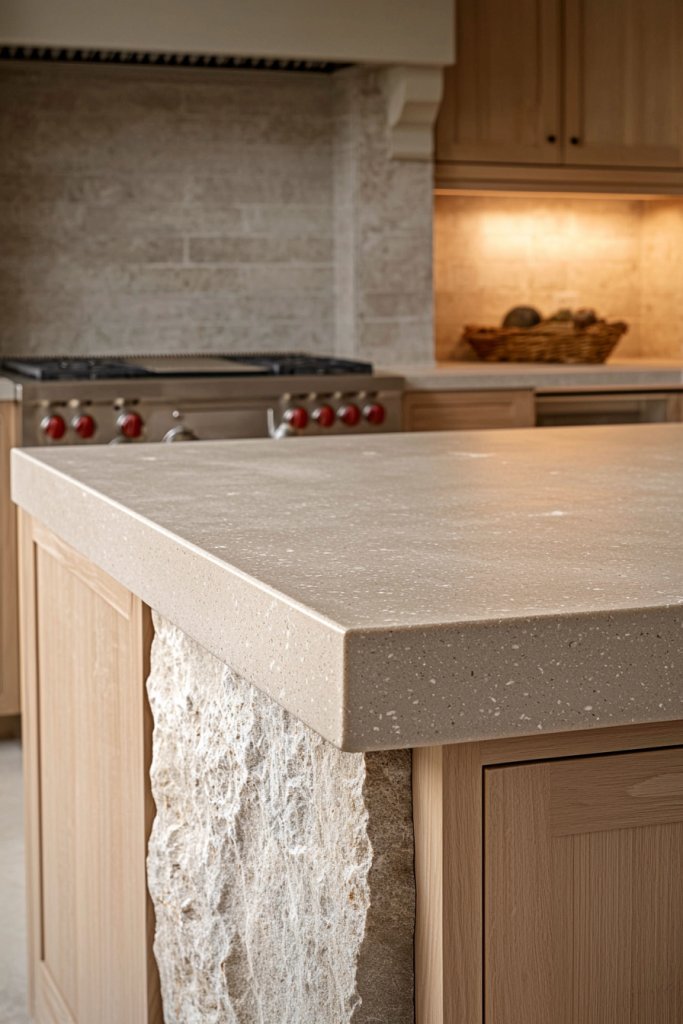
Elevate your Japandi kitchen with the timeless beauty of ceramic or stone countertops, bringing a natural, grounding element to your serene space. These surfaces not only enhance the aesthetic but also create a tactile connection to nature that promotes calm and mindfulness while cooking or gathering.
Imagine a kitchen with smooth, matte stone countertops in soft shades of gray or warm beige, their subtle variations echoing the natural textures of river stones or slate. The surfaces feel cool and solid under your fingertips, offering a sense of durability and understated elegance.
Paired with light wood cabinetry and minimalist hardware, these countertops provide a seamless flow that emphasizes simplicity and tranquility. The gentle sheen of ceramic or stone adds a refined touch without overpowering the calm, neutral palette, inviting a sensory experience rooted in natural materials and understated beauty.
Recreating this look is straightforward: start by selecting quality ceramic or stone slabs, such as limestone, marble, or concrete, in neutral tones. If these materials are out of reach, look for durable laminate options with a stone or ceramic pattern that mimics the natural look.
Install the countertops with clean, straight edges to maintain the minimalist aesthetic, and pair them with light wood cabinetry and simple fixtures. Regular sealing or cleaning with gentle, natural products will keep the surfaces looking fresh and pristine, helping your kitchen stay both stylish and functional with minimal fuss.
8. Use Subtle Lighting with Warm LED Fixtures for a Cozy Glow
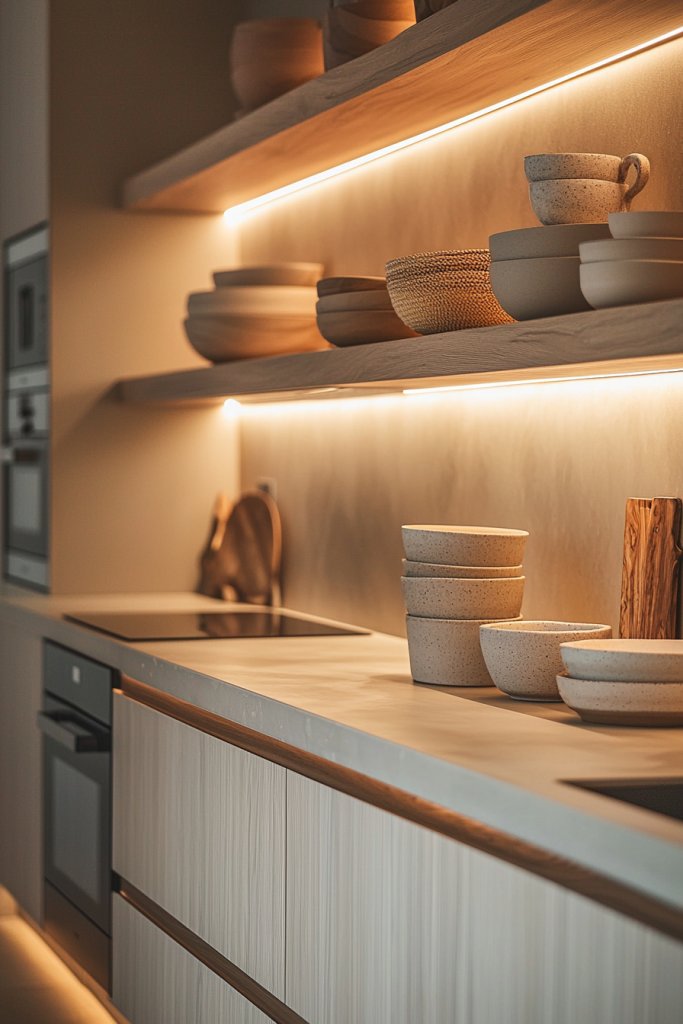
Soft, warm lighting can transform a simple kitchen into a cozy, inviting space where calmness prevails. Using subtle LED fixtures with a warm hue creates an ambient glow that gently envelops the room, perfect for relaxing evenings or intimate gatherings.
This gentle illumination emphasizes the clean lines and natural textures typical of Japandi design, fostering a peaceful atmosphere. Visualize a kitchen softly illuminated by concealed LED strip lights placed under floating cabinets or along the edges of open shelving.
The warm glow highlights natural wood finishes, smooth matte appliances, and textured ceramics, casting gentle shadows that add depth and warmth to the space. The lighting’s subtle radiance enhances the neutral color palette—creamy beiges, soft taupes, and muted greys—while inviting tactile textures like woven textiles and ceramic accents.
The overall effect is one of serenity, where light feels almost weightless, encouraging relaxation and mindfulness. To achieve this cozy glow, start by installing warm LED strip lights beneath cabinets or along ceiling coves.
Opt for fixtures that emit a soft, amber-toned light—alternatives include dimmable warm-white bulbs or vintage-inspired filament LEDs. Keep the lighting discreet and avoid harsh overheads to maintain the subtle vibe.
Use dimmer switches to control brightness and create the perfect mood for different times of day. With simple tools and a bit of guidance, you can easily add this gentle layer of warmth to your Japandi kitchen, making it a sanctuary of calm.
9. Incorporate Floating Shelves to Maximize Space and Maintain Simplicity
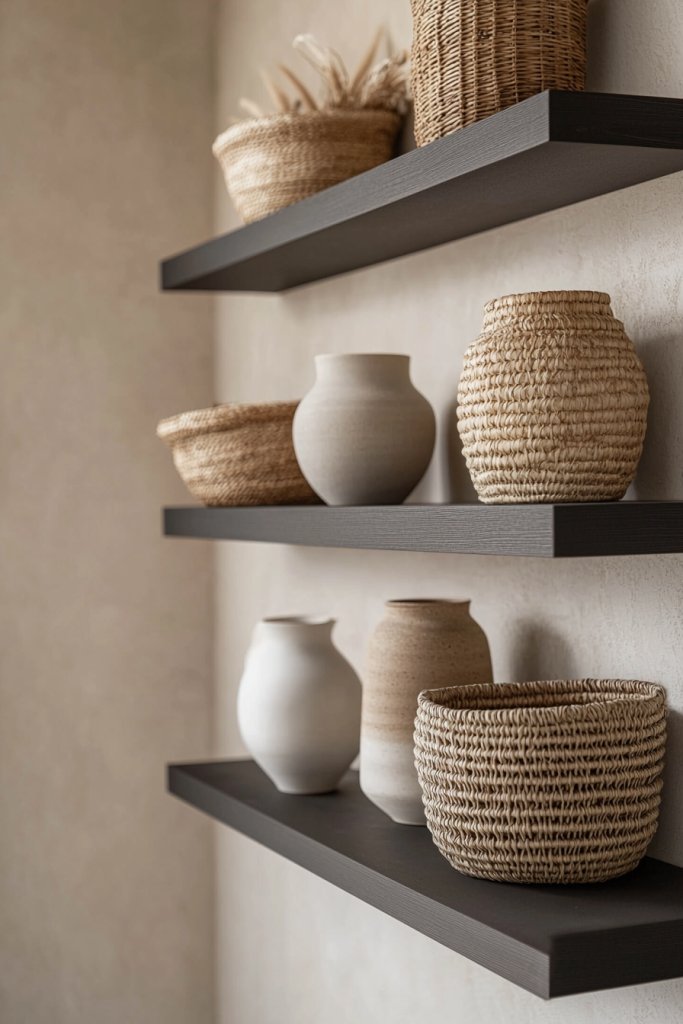
Floating shelves are a clever way to maximize storage while keeping your kitchen looking sleek and uncluttered, perfectly aligning with Japandi’s minimalist ethos. They offer a lightweight, airy feel that prevents the space from feeling crowded, all while providing a stylish platform for decorative and functional items.
Imagine a row of slim, matte black or natural wood floating shelves mounted seamlessly against a soft, neutral wall. These shelves display a curated selection of simple ceramic jars, woven baskets, and textured ceramics in earthy tones like warm beige, soft gray, and muted browns.
The open design invites light to dance across the surfaces, creating subtle shadows that add depth and calmness. The textures—smooth porcelain, rough woven baskets, and matte finishes—enhance the tactile experience, making the space feel warm and inviting without overwhelming the senses.
To incorporate floating shelves into your kitchen, start by choosing durable, wall-mounting brackets and sturdy wood or MDF boards finished in matte or natural wood veneer. Securely attach the shelves at varying heights for visual interest, or keep them aligned for a clean, uniform look.
You can find ready-made floating shelf kits at most hardware stores, or opt for custom pieces for a perfect fit. Decorate with minimalist ceramics, small kitchen tools, or stylish storage containers—just be sure to keep clutter minimal to preserve that serene, balanced aesthetic.
10. Add Scandinavian-Inspired Bar Stools for Functional Elegance

Adding Scandinavian-inspired bar stools to your kitchen is a simple yet impactful way to elevate your space with functional elegance and clean design. These stools bring a touch of Nordic minimalism that perfectly complements the calm and balanced aesthetic of Japandi style.
Imagine sleek, slender stools with light wood legs and smooth, rounded seats upholstered in neutral tones like soft beige or muted gray. The design is unpretentious, with gently curved edges and a low profile that encourages easy conversation and effortless movement.
The natural wood grains add warmth and texture, contrasting beautifully with the matte finishes of your surrounding cabinetry and countertops. The overall look exudes understated sophistication, creating a cozy yet uncluttered atmosphere that invites you to linger.
To recreate this look, start by selecting Scandinavian-inspired bar stools with simple lines and natural materials—think light oak or ash with minimal hardware. You can find options with fabric or leather cushions for added comfort, or opt for all-wood designs for a more streamlined appearance.
Position the stools at your kitchen island or breakfast bar, ensuring they are proportionate to the counter height. If sourcing identical pieces isn’t possible, look for similar styles at furniture stores or online retailers, and consider DIY options like refinishing or reupholstering existing stools to match your aesthetic. With just a few thoughtful choices, you can introduce this elegant, functional element effortlessly into your Japandi-inspired kitchen.
11. Utilize Hidden or Integrated Storage Solutions for a Clean Surface
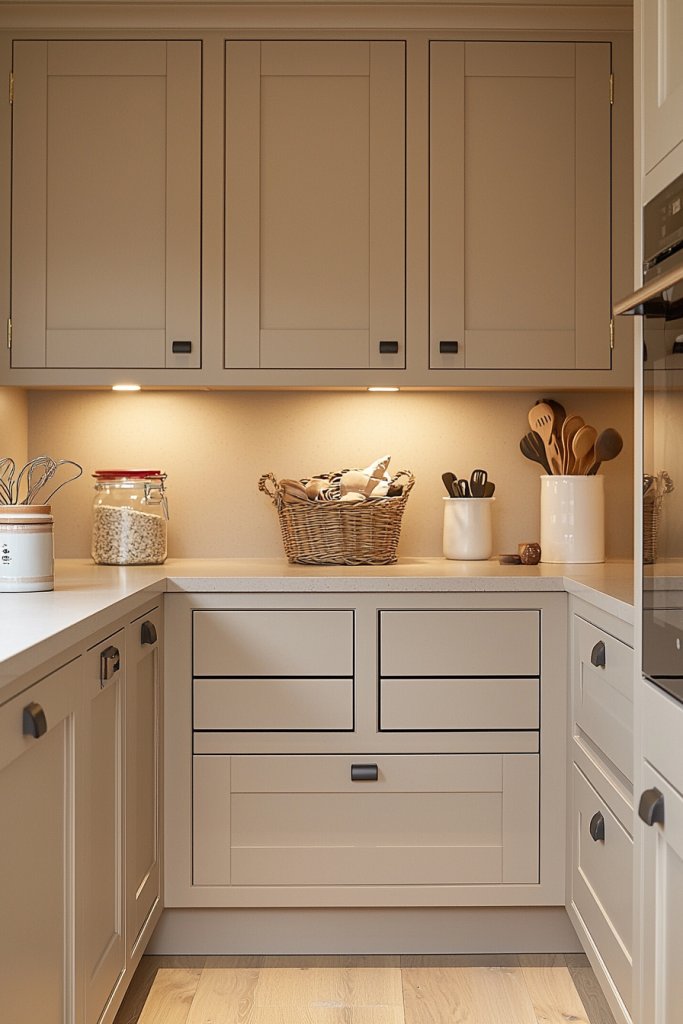
Creating a clutter-free kitchen is one of the cornerstones of Japandi design, and hidden or integrated storage solutions are perfect for maintaining that minimalist aesthetic. This approach involves designing cabinetry and storage that seamlessly blend into the overall look, hiding away everyday items so surfaces stay sleek and tidy.
Think of drawers with built-in organizers, pull-out pantry shelves, or cabinets with push-to-open mechanisms that eliminate visible handles. This not only enhances the clean lines but also fosters a sense of calm and order.
Visualize a kitchen where the cabinets are a soft matte beige or warm ash, with recessed handles or touch-open latches. The countertops are clear, save for a few carefully selected items like a simple ceramic jar or a woven basket for utensils, all kept out of sight in clever storage compartments.
The overall effect is a space that feels spacious and uncluttered, with a subtle harmony between form and function. The muted color palette and streamlined storage create a soothing environment that invites you to cook and relax without visual noise.
To implement this, start by choosing cabinetry with built-in storage options, such as deep drawers or pull-out shelves, which can be sourced from most home improvement stores. Opt for push-to-open hardware if you prefer handleless fronts for an even cleaner look.
Incorporate storage solutions like under-sink organizers or hidden spice racks behind cabinet doors. Keep everyday essentials out of sight by investing in baskets or bins that can be tucked away inside cabinets. With a little planning, you can achieve a beautifully minimalist kitchen that’s both practical and visually calming.
12. Introduce Textural Contrast with Rattan or Woven Elements
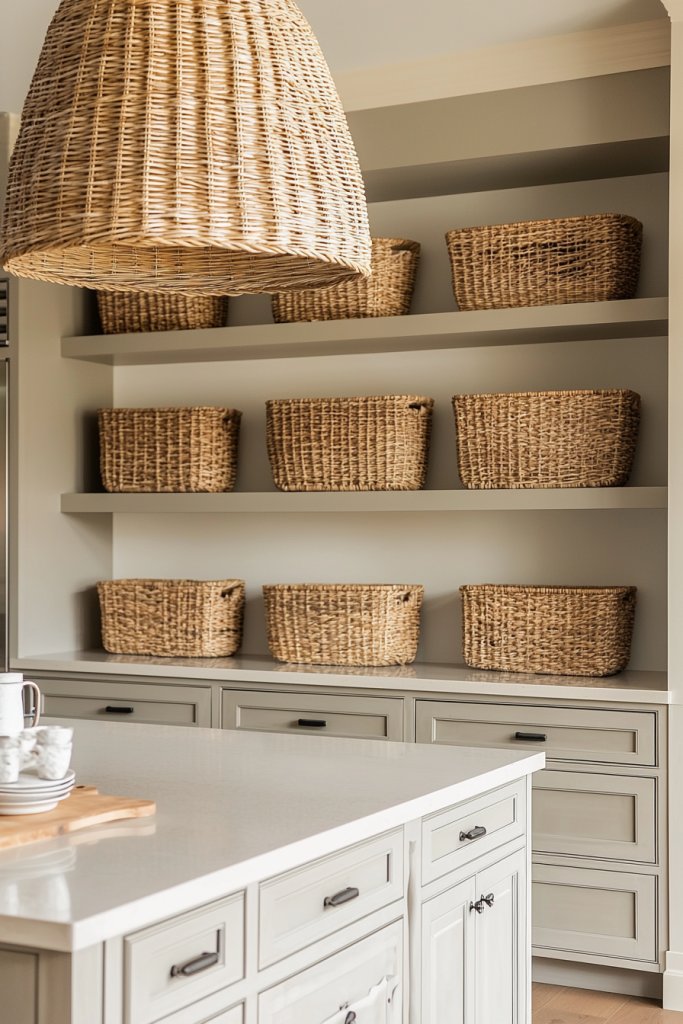
Adding textural contrast is essential in Japandi kitchens to create visual interest without cluttering the space. Rattan, wicker, and woven elements bring warmth and tactile appeal, balancing the sleekness of wood and smooth surfaces.
These natural textures serve as both decorative accents and functional pieces, whether in seating, storage baskets, or decorative accessories, enriching the overall aesthetic with subtle depth. Imagine a kitchen with a soft, neutral color scheme—light beiges, creams, and gentle grays—accented by a rattan pendant light hanging above the island or a set of woven storage baskets on open shelves.
The tactile quality of these materials invites touch, adding coziness to the space. Woven placemats or a rattan tray on the countertop can also introduce subtle contrast, breaking up the visual uniformity of smooth surfaces.
This combination of textures enhances the calm, natural ambiance that Japandi design seeks to achieve. To incorporate these elements, select woven baskets made from rattan or seagrass to store utensils, fruits, or kitchen linens.
Add a rattan pendant light or a set of woven placemats to your table or counter area. These items are widely available at home decor stores or online, often at affordable prices.
When choosing woven pieces, aim for natural, untreated materials for authenticity and sustainability. Combining these textured accents with your existing cabinetry and countertops will elevate the space, making it feel warm, inviting, and balanced.
13. Incorporate Simple, Geometric Kitchenware for a Cohesive Look
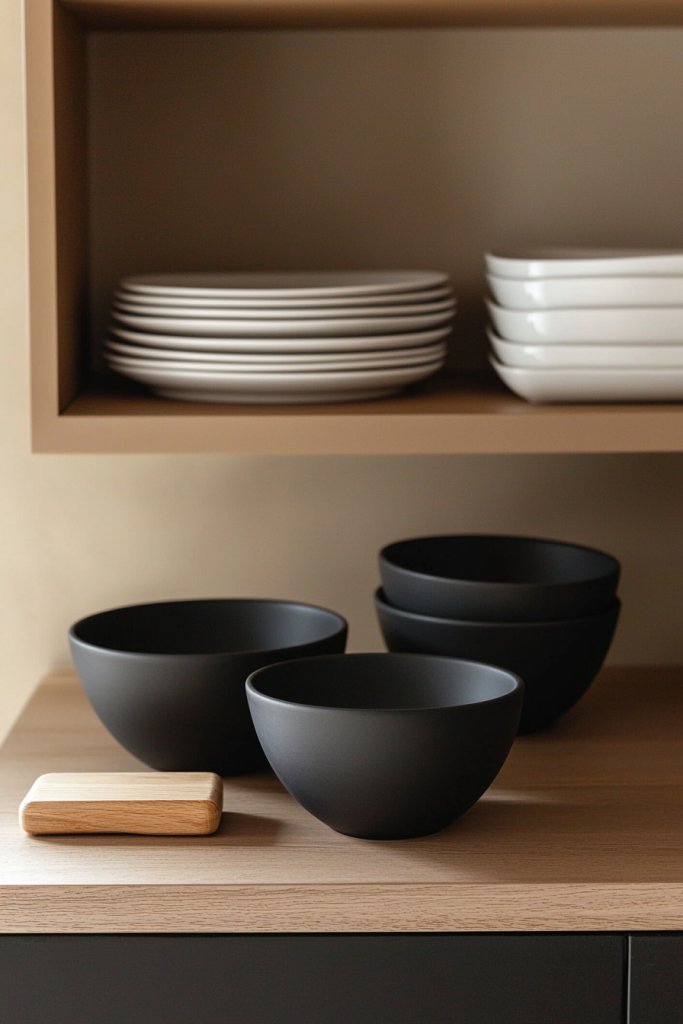
In a Japandi kitchen, every element contributes to the overall sense of harmony, including the choice of kitchenware. Simple, geometric shapes—such as round bowls, rectangular trays, or angular mugs—reinforce the minimalist aesthetic while adding visual coherence.
These pieces act as both functional items and subtle design elements, tying the space together with their clean lines and understated elegance. Picture a set of matte black ceramic bowls with smooth, rounded edges nestled beside a neutral-toned wooden spoon rest.
Or imagine a series of rectangular, unadorned porcelain plates stacked neatly on open shelves, their crisp lines complementing the cabinetry. The color palette is muted—think soft creams, earthy browns, or charcoal greys—allowing the geometric forms to stand out without overwhelming the space.
The overall look is calm, organized, and effortlessly stylish, with each piece contributing to the harmonious flow. To achieve this, choose kitchenware with simple geometric forms from brands or stores specializing in Scandinavian or minimalist designs.
Opt for neutral tones like whites, grays, or blacks, which blend seamlessly into the Japandi aesthetic. Mix and match shapes but keep the color palette consistent for cohesion.
When arranging, display select pieces openly for a curated look or store extras in cabinets for a tidy appearance. This approach transforms everyday utensils into understated decor that enhances the minimalist, balanced vibe of your kitchen.
14. Use Low-Profile Backsplashes in Neutral Tones for a Seamless Flow
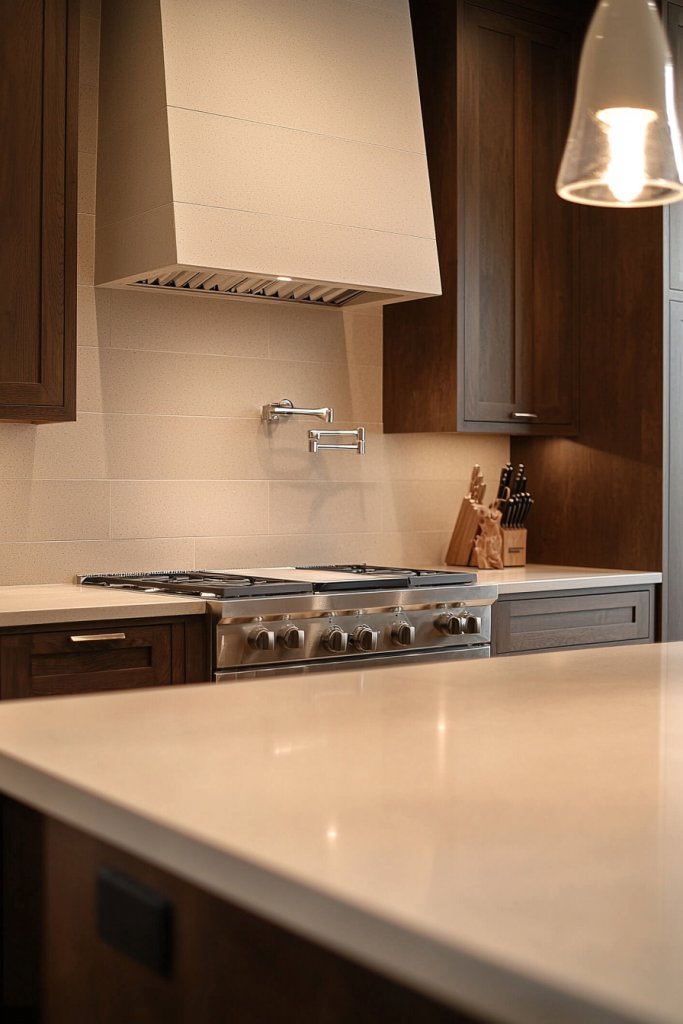
A low-profile backsplash in neutral tones is a key element for maintaining the clean, unobtrusive look characteristic of Japandi kitchens. Instead of bold patterns or vibrant colors, this approach employs subtle, seamless surfaces that blend into the surrounding cabinetry and countertops, creating a continuous visual flow.
This technique emphasizes simplicity and calmness, allowing other design details to shine. Visualize a kitchen with a backsplash made from large, matte tiles in a soft beige or warm gray, extending just above the countertop’s edge.
The tiles are installed with minimal grout lines, making the transition between surfaces almost invisible. The overall effect is a space that feels open and cohesive, with the backsplash acting as an understated backdrop to the natural wood cabinetry and sleek fixtures.
The neutral palette and smooth surfaces evoke a sense of tranquility, perfect for a calm and balanced kitchen environment. To implement, select large-format tiles in neutral shades, such as stone-look porcelain or matte ceramic, and install them with thin, matching grout lines for a seamless appearance.
Alternatively, a continuous concrete or plaster wall can serve as a low-profile backsplash, offering a smooth, uniform surface. Keep the design simple and avoid excessive detailing or contrasting colors. With a straightforward installation and a focus on subtlety, this approach ensures your kitchen remains serene and harmonious, aligning perfectly with Japandi principles.
15. Opt for Soft, Rounded Edges in Countertops and Cabinets
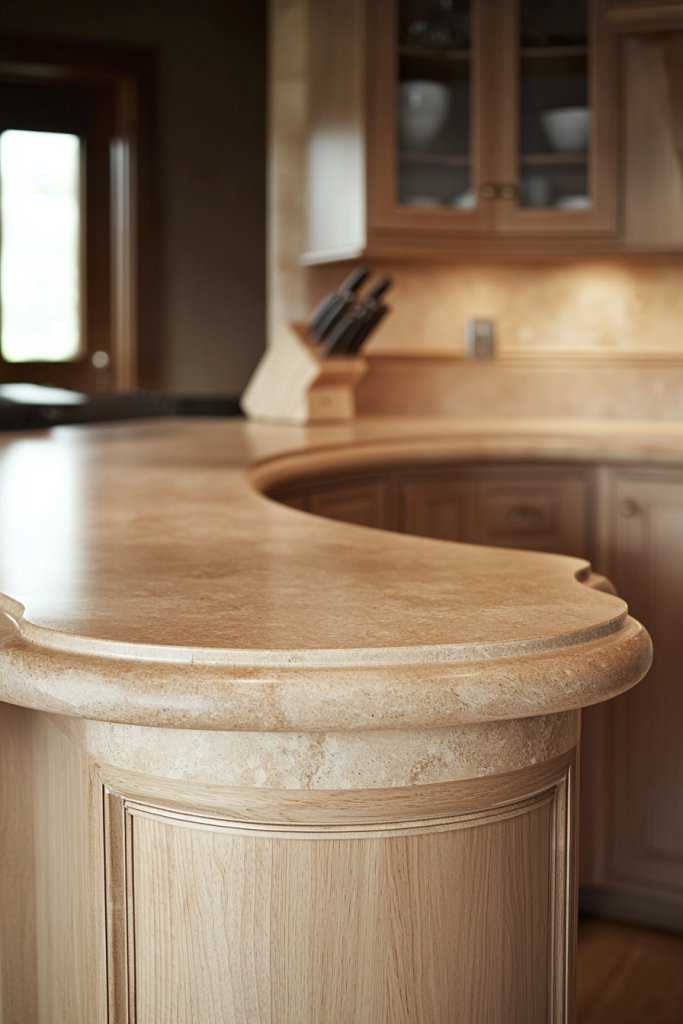
In Japandi design, soft, rounded edges contribute to the space’s overall sense of calm and approachability. Sharp corners and angular lines can feel harsh; replacing them with gently curved or beveled edges creates a more organic, inviting atmosphere.
This subtle detail enhances the tactile experience and softens the visual lines, making the kitchen feel more harmonious and balanced. Imagine a kitchen where the countertop edges gently curve or are beveled, providing a smooth transition from surface to edge.
The cabinets might feature rounded corners or slightly recessed handles, contributing to a cohesive, flowing aesthetic. The overall effect is a space that feels comfortable and welcoming, with lines that evoke the natural softness found in organic shapes.
The subtle curvature also adds a handcrafted, artisanal feel that aligns with the Japandi ethos of understated elegance and natural beauty. To achieve this, choose countertops with rounded or bullnose edges—these are readily available from most countertop suppliers.
When selecting cabinetry, opt for designs with softened corners or built-in rounded edges. If existing pieces have sharp edges, consider professional edge finishing or adding decorative trim that mimics the soft curve. This small but impactful detail enhances the overall tranquility of your kitchen, making everyday use a more pleasant, tactile experience while reinforcing the minimalist, natural aesthetic of Japandi design.
16. Integrate Built-In Appliances for a Sleek, Uncluttered Space
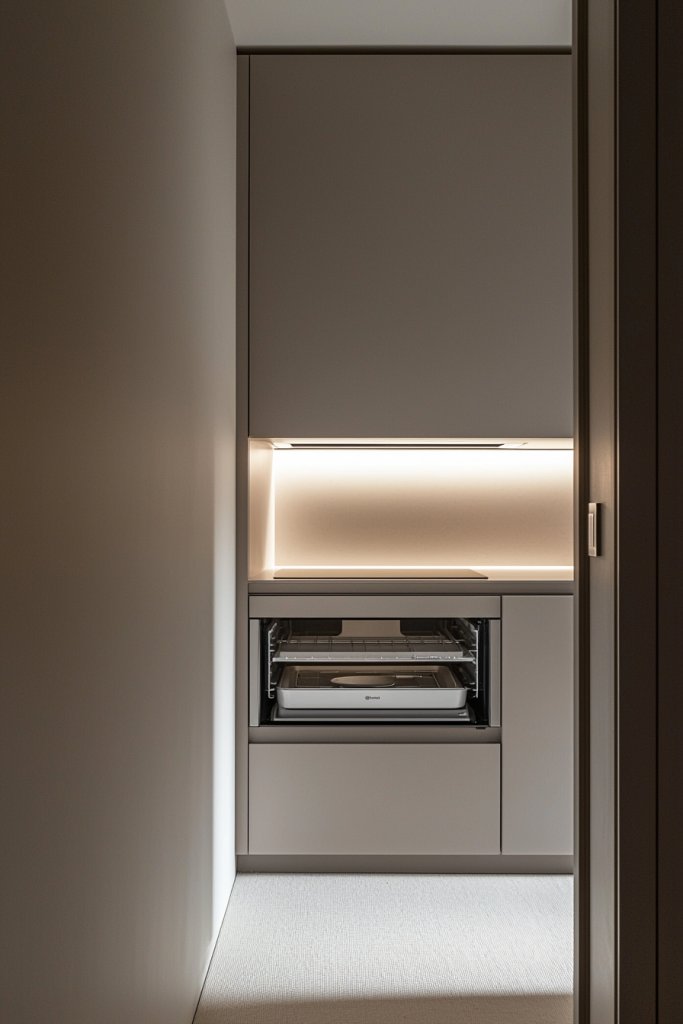
A seamless kitchen with built-in appliances transforms chaos into calm, embodying the Japandi ethos of minimalism and functionality. This approach not only streamlines your cooking space but also elevates its aesthetic, creating a harmonious environment that feels both modern and warm.
Picture a kitchen where your oven, microwave, and even refrigerator are subtly integrated into the cabinetry, with sleek panels that match or complement the surrounding wood or matte finishes. The appliances sit flush with the cabinetry, eliminating bulky edges and visual clutter.
Soft, warm lighting highlights the clean lines, while neutral-toned countertops and understated hardware enhance the calm atmosphere. The overall space feels spacious, organized, and inviting, with a sense of effortless order that encourages relaxation during meal prep.
To achieve this look, start by choosing appliances designed for built-in installation—many brands offer models specifically crafted for seamless integration. Measure your space carefully and plan your cabinetry layout, ensuring enough clearance for appliances while maintaining the minimalist aesthetic.
Install custom cabinetry or modify existing units to hide appliances behind matching panels, using adhesive or magnetic strips for easy access. For a budget-friendly alternative, consider using panel-ready appliances and coordinating your cabinetry with matte or natural wood finishes to maintain the calming, cohesive look. Keep the space clutter-free by using internal drawers and hidden storage to stow away small kitchen gadgets.
17. Select Subdued, Earth-Tone Tiles for the Floor to Enhance Calmness
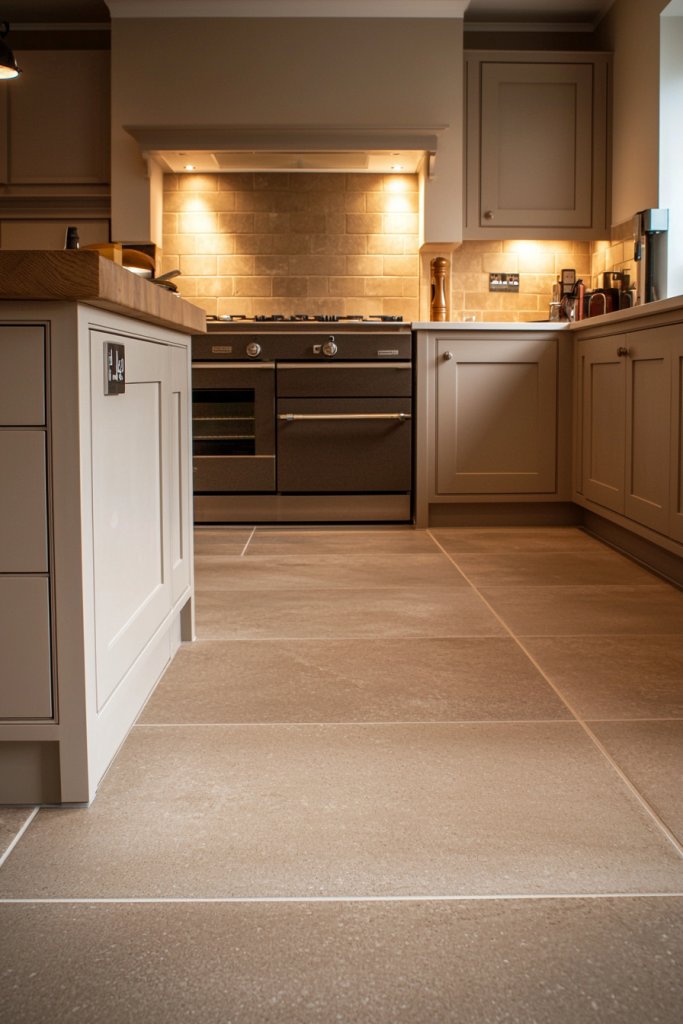
The foundation of a tranquil Japandi kitchen often lies in its flooring—subtle, subdued tiles in earthy hues establish a grounding atmosphere that promotes relaxation and balance. These natural tones serve as a calming backdrop, complementing the overall minimalist design.
Imagine walking into a kitchen with soft beige, warm taupe, or muted gray tiles arranged in a simple, understated pattern. The matte finish of these tiles absorbs light rather than reflecting it, adding to the serene mood.
The textured surface feels warm underfoot, evoking the natural feel of stone or clay, while the neutral palette allows other design elements like wood accents and textiles to shine without overwhelming the senses. This flooring choice visually anchors the space, creating a seamless flow from room to room and reinforcing the sense of calm that Japandi design aims for.
To implement this, select tiles made from natural materials like porcelain with matte finishes or ceramic in subdued earth tones. For a more sustainable option, explore clay or cork tiles which also offer warmth and texture.
Measure your space carefully and consider laying tiles in a simple grid or herringbone pattern for subtle visual interest. For easier installation and maintenance, choose standard sizes (e.g., 12”x12”) and opt for grout colors that blend seamlessly with the tiles, such as soft gray or beige. This flooring choice offers a durable, stylish foundation that effortlessly enhances the kitchen’s tranquil vibe.
18. Use Monochromatic or Tonal Decor Accents for Visual Harmony

Creating a cohesive and calming space in your Japandi kitchen can be achieved through the strategic use of monochromatic or tonal decor accents. This design technique emphasizes harmony and subtle sophistication, fostering a peaceful environment.
Visualize a kitchen where the decorative touches—such as ceramic jars, woven textiles, or small sculptures—are all in shades of soft gray, warm beiges, or muted browns. These accents are carefully selected to complement the overall color palette, adding depth without disrupting the minimalist serenity.
Textures like matte ceramics, smooth woods, and woven fabrics create visual interest and tactile richness, making the space feel layered yet cohesive. The uniform color scheme ensures that no single element dominates, allowing your eye to rest and appreciate the subtle beauty of each piece, enhancing the tranquil atmosphere.
To incorporate this concept, choose decor items in similar tones—think beige linen towels, gray ceramic canisters, or taupe woven placemats. Stick to a limited color palette and avoid overly bright or contrasting hues.
Select materials with matte or natural finishes to reinforce the calm aesthetic. Mix textures thoughtfully—smooth ceramics with rough woven baskets—to add depth without clutter.
Keep clutter minimal, and rotate or swap decor seasonally to maintain visual harmony. This approach creates a soothing, balanced environment that feels both elegant and restful.
19. Incorporate Functional yet Stylish Storage Jars and Containers

In a Japandi kitchen, clutter is kept at bay with stylish storage solutions that blend function with beauty. Well-chosen jars and containers not only organize your essentials but also serve as decorative accents that enhance the room’s serene vibe.
Picture sleek, matte-finished ceramic jars in neutral tones like soft gray or warm beige, sitting neatly on open shelves or countertops. Their clean, simple shapes and subtle textures contribute to the minimalist aesthetic.
These containers hold dry goods such as rice, beans, or spices, making everyday ingredients easily accessible while maintaining a clutter-free surface. The uniformity in size and material creates a cohesive visual rhythm, adding to the calm and ordered ambiance of the space.
When chosen thoughtfully, these storage pieces become part of the decor, elevating practicality into an artful element. To implement, select stainless steel, ceramic, or glass jars with simple lids—preferably in matte finishes to avoid glare.
Use labels or leave them unlabeled for a seamless look. Group similar items together for visual consistency and consider stacking or nesting containers to save space.
For an affordable, eco-friendly option, repurpose recycled glass jars or vintage ceramics. Position these containers near your prep area or on open shelves, ensuring they’re both accessible and aesthetically pleasing. This strategy keeps your kitchen organized, functional, and visually harmonious.
20. Choose Simple, Elegant Lighting Pendants in Natural Materials
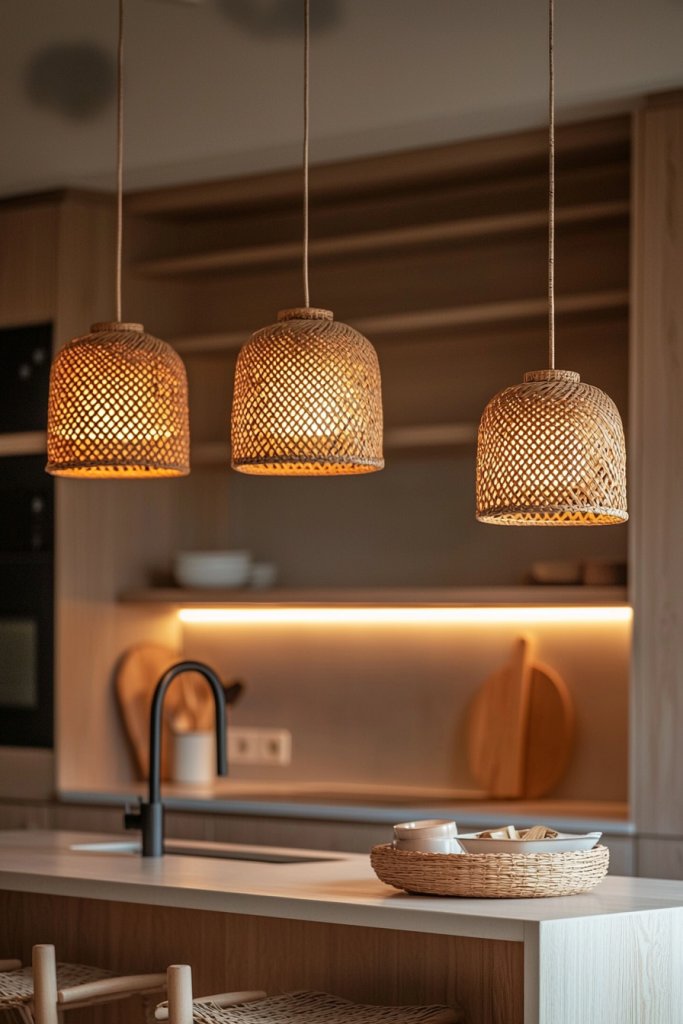
Lighting in a Japandi kitchen should evoke warmth and simplicity, serving as both a functional necessity and a design statement. Pendant lights crafted from natural materials add an understated elegance that complements the overall serene aesthetic.
Imagine pendant fixtures made from light-colored wood, rattan, or woven bamboo, hanging gracefully over the island or dining area. Their soft, natural textures and neutral tones create a warm glow, casting gentle light that enhances the calming environment.
The minimalist design of these pendants—think sleek, rounded shapes or simple geometric forms—avoids visual clutter while adding a subtle focal point. The combination of warm LED bulbs with natural shades produces a cozy, inviting ambiance perfect for everyday routines or intimate gatherings, reinforcing the Japandi ideals of harmony and understated luxury.
To incorporate this idea, look for pendant lights with natural fiber or wood finishes from brands like West Elm or H&M Home. Mount them at appropriate heights—generally 24-30 inches above the countertop—to balance functionality with style.
For budget-conscious options, consider DIY pendant kits or repurposing woven baskets or wooden bowls with hanging cords. Ensure the fixtures are compatible with dimmable LED bulbs to adjust the mood as needed. These simple yet elegant lighting choices serve as both illumination and decorative elements, enriching your space with warmth and subtle sophistication.
21. Design an Open-Concept Layout to Promote Airiness and Flow

Creating an open-concept layout in a Japandi kitchen is essential for cultivating a sense of spaciousness and harmony. This approach eliminates unnecessary walls or barriers, allowing light and air to circulate freely, which enhances the calming and balanced atmosphere that Japandi style aims for.
It also encourages seamless integration with adjoining living or dining areas, fostering a sense of community and ease. Imagine walking into a kitchen where the space feels expansive, with a clear line of sight across the room.
Light-colored wooden floors extend throughout, reflecting soft daylight from large windows. The countertops are uncluttered, with sleek, handleless cabinets in muted tones, while a minimalist island serves as both workspace and casual dining spot.
Textured textiles, like a woven rattan stool or a soft linen runner, add warmth without cluttering the visual flow. Overall, the design emphasizes simplicity, spaciousness, and fluid interaction between zones.
To recreate this, start by removing or minimizing walls that separate your kitchen from adjacent rooms. Use a consistent neutral color palette—think warm beige, soft gray, or light wood tones—to unify the entire space.
Incorporate a large, open countertop area or island as a central feature. Keep furniture and decor minimal; opt for built-in storage solutions and avoid overcrowding. Finally, maximize natural light with sheer curtains or unobstructed windows, making the space feel airy and inviting.
22. Add Subtle Decorative Touches with Sculptural Ceramics or Vases
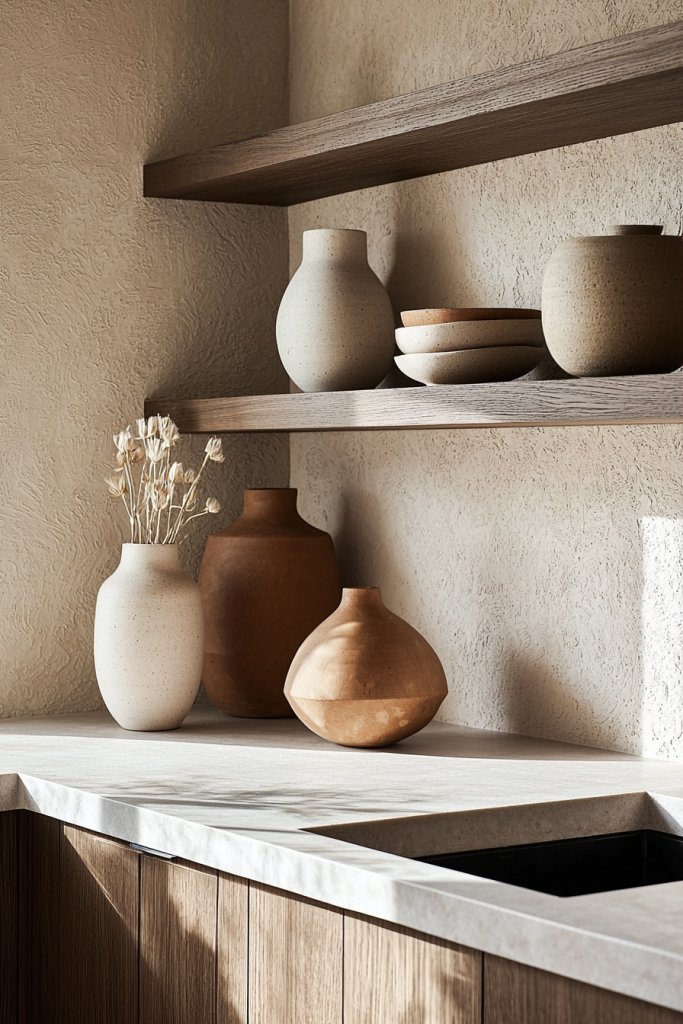
In a Japandi kitchen, understated decorative objects elevate the space without overwhelming its minimalist aesthetic. Sculptural ceramics and elegant vases serve as subtle focal points, adding a touch of artistry and personality while maintaining the calm, balanced vibe.
These pieces help to create visual interest through their form, texture, and muted colors, enriching the overall design. Picture a simple, matte black ceramic vase with a rounded silhouette sitting on a wooden shelf, or a textured clay bowl with organic contours placed near the sink.
The ceramics are often neutral-toned—think warm terracotta, soft gray, or creamy whites—and feature clean, graceful lines that complement the overall aesthetic. These objects can be filled with seasonal flowers, dried botanicals, or left empty to highlight their sculptural qualities.
Their tactile textures invite gentle visual exploration, adding depth and warmth. To incorporate these touches, select a few well-crafted ceramics in complementary tones and shapes.
Place them strategically on open shelves, countertops, or within glass-front cabinets for subtle display. Look for artisan-made pieces or DIY options if you prefer a personal touch. Keep the collection modest—two or three key pieces are enough—so they don’t clutter the space but instead serve as quiet yet impactful accents that enhance the Zen-like serenity of your kitchen.
23. Maintain a Consistent, Balanced Symmetry in Layout and Decor Elements

Achieving balance and harmony in a Japandi kitchen is rooted in symmetry—carefully arranging elements so that the space feels orderly and calming. Consistent, mirrored placement of decor and functional elements creates visual stability, reinforcing the Zen-inspired aesthetic that prioritizes calmness and effortless beauty.
Visualize a kitchen where matching pendant lights hang at equal heights over the island, or where symmetrical open shelving displays balanced collections of ceramics and textiles. Cabinet doors are aligned precisely, and workspaces are arranged to promote smooth flow, with tools and accessories kept tidy and intentionally placed.
This symmetry extends to color and material choices, with repeated use of soft neutrals, natural woods, and subtle textures that create a cohesive, balanced environment. To implement, start by planning your layout with symmetry in mind: position appliances, lighting, and storage so they mirror each other across central axes.
Use matching cabinet hardware, identical shelf brackets, or pairs of decorative objects to reinforce balance. Focus on a monochromatic or tonal color scheme to unify the visual elements. Regularly step back and assess the overall harmony, adjusting decor and arrangement until a sense of calm and order prevails—your kitchen will radiate that perfect Japandi equilibrium.
Conclusion
Transforming your kitchen into a serene Japandi sanctuary is all about blending minimalism, natural elements, and thoughtful details. From soothing color palettes and streamlined cabinetry to textured textiles and subtle lighting, these ideas foster calm and balance in your space.
Embrace these design principles to create a harmonious environment that promotes relaxation and functionality. Start infusing your kitchen with Japandi elegance today and enjoy the timeless beauty of simplicity.
Leave a Reply